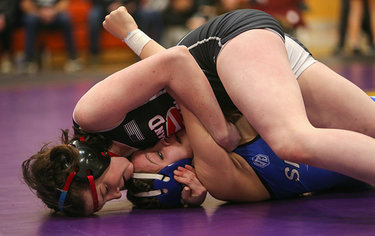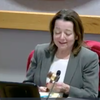GCSD super proposes $125M budget for next year that maintains programs, stays under tax cap
Enterprise file photo — Michael Koff
Guilderland’s Nadia Hawrylchak, pictured here in January competing in the first-ever Section 2 sectional championships for girls’ wrestling, qualified for the state competition. This week, Nadia, a founding member of the team, told the school board, “The addition of a girls-only coach will benefit the athletes, other coaches, and the entire Guilderland wrestling program.” That post is included in the 2023-24 budget draft.
GUILDERLAND — Superintendent Marie Wiles on Tuesday presented a draft of next year’s school budget — the $125 million spending plan is up 4.6 percent from this year with an estimated tax-levy increase of 2.7 percent.
That increase stays under the state-set levy limit, meaning a simple majority of voters on May 21 is needed to pass the budget. In the decade since the state adopted the tax cap, Guilderland has never gone over the limit. Last year, the budget passed with over 70 percent of the vote.
“We wanted to maintain the things that we have and the ways we can support students,” Wiles told school board members at their March 5 meeting. “We wanted to put in as many high-priority items funded through grant dollars,” she said of the federal COVID funds that will tail off in September.
“And honestly, as I stand here today, I’m pleasantly surprised that we could get as many of them in here as we could. Two months ago, I would not have thought that possible.”
The district has spent $5.7 million to pay tax refunds after court challenges, and drained its reserve for tax certiorari cases. So it made a strategic decision to pay Crossgates Mall, once the most recent tax challenges are decided, not entirely out of the operating budget but rather by borrowing the money and paying off the bond over a decade.
“We have to address them,” Wiles said of tax refunds, “but we don’t want to do it at the expense of not being able to fulfill our mission.” The district’s mission she had explained at the start of her presentation is to make each and every student ready for the future.
“And, if we were to pay Crossgates five-plus million out of this budget, this presentation would be … a list of things we have to cut,” Wiles said, and would include increasing class sizes.
“So we’re making a conscious decision here to balance what our priorities are, meet our obligations, but not at the expense of our students,” said Wiles, who also said, “We understand that taxpayers keep us in business here and we want to respect them.”
The district’s assistant superintendent for business, Andrew Van Alstyne, put it succinctly: “Every dollar we spend on tax certiorari is a dollar we can’t spend in the classroom.”
He also said, “We want to spread out the costs because it’s so large that putting it in any one budget would have a substantial impact on operations.”
On the positive side, Wiles said the district anticipates being “at the end of all our tax certiorari litigation” and so “we think we can save about $85,000 in attorney’s fees for next year.”
Guilderland is anticipating about $40 million in state aid based on the governor’s proposal for the state budget, about $350,000 less than originally anticipated. Wiles stressed that much could change before the legislature adopts the final state budget with an April 1 deadline that is frequently overridden.
Most of the rest of Guilderland’s budget is funded by property taxes, which is why the recent tax certiorari cases have been such a strain.
Next Tuesday, March 12, Guilderland administrators will answer budget questions from the school board and the public and the board is slated to adopt the spending plan on April 16.
Wiles started her presentation by going over results from an online survey that showed the top priority for parents and school board members as well as faculty and staff is maintaining low class sizes. Students had that as a fifth priority topped by athletics, arts, electives, and academic support.
The proposed budget maintains class sizes.
Van Alstyne went over enrollment figures that show, while Guilderland will have a small overall increase in enrollment next year, there will be “a pretty significant redistribution” — elementary enrollment will drop markedly while middle and high school enrollment increase slightly.
Consequently, six teaching posts have been eliminated in next year’s plan while the average elementary class size will be 20.5 students.
At the same time, the budget has four unassigned teaching posts so that teachers can be added as needed as enrollment shifts in the months ahead.
As with any school budget, the lion’s share of expenses is for salaries and benefits. In rough numbers, 50 percent of next year’s budget is slated for salaries, 26 percent for benefits, 7 percent for debt service, 7 percent for contractual services, 6 percent for BOCES, and the remaining 4 percent for everything else.
With 4,850 students this year, Guilderland has 711 full-time employees and 233 part-time workers. This includes 508 teachers, 409 support staff, and 27 administrators or supervisors.
Health insurance costs account for the biggest year-over-year increase, over $2 million, an increase of about 12 percent. The second biggest increase is in instructional salaries, which are set through contract negotiations.
Also, Van Alstyne said, since the district does not have enough of its own bus drivers, it has to contract out some routes and the costs for that “have been rising exponentially.”
Changes
Wiles went over the changes the spending plan will bring at each school level.
In the five elementary schools, in addition to decreasing enrollment, she said that last June both enrichment teachers, who together served all five schools, resigned to move on to other jobs. The money that had been spent on those teachers will now be spent on keeping two posts for reading teachers, which had been paid for with federal COVID funds.
A grant-funded social worker who served three elementary schools will also be funded in next year’s general operating budget. “The social-emotional needs of our students are not going away,” said Wiles.
“We have a big increase in the numbers of students in self-contained programs at the elementary level,” said Wiles. “So we need to host four classrooms to support the needs of these students.”
About $340,000 came from a grant this year to pay for one self-contained classroom, which includes a special-education teacher, teaching assistant, and part-time support from a speech specialist and social worker. That will now come from the general fund.
Another change is that three classes of special-needs students had been housed at Altamont Elementary School. Next year, two each will be housed at Guilderland and Pine Bush elementary schools. This is partly to reduce travel time, said Wiles, and also to provide greater opportunity for the special-needs students to mainstream into other classrooms since the Guilderland and Pine Bush schools are both much bigger than Altamont Elementary.
At the middle school, the district is continuing its initiative from last year to lower class sizes, keeping classes in each grade level in the mid- to low twenties.
Also at the middle school, four-tenths of a teaching position for Spanish will be added, allowing the district to advertise for a full-time teacher.
“Part-time positions in everything, but particularly the languages, are almost impossible to fill,” said Wiles.
A pilot program for Unified physical education classes, where students with and without disabilities are in the same class, will account for a new teaching post. Also a three-year contract for the math curriculum is being renewed.
At the high school, clerical support is being expanded in the counseling office and part-time posts for Spanish and Italian teachers are being added.. Also, graphing calculators are being replaced.
Athletics
The March 5 meeting opened with passionate pleas from flag football players for a girls’ flag football team at the high school.
When the request was voiced at the board’s last meeting, Wiles had said of the $12,000 cost of starting a team, “In the end, we felt it was fairest to our existing programs and to the overall process that we use to make really tough decisions about what ends up in the budget to put it in the queue for next year.”
On March 5, several female wrestlers and their parents made the case for hiring a dedicated coach for that team, which started two years ago.
“Just in the last few years, we have girls’ golf, we have Unified bocce, we have Esports, and now girls’ wrestling,” said Wiles, pointing to the budget funds needed to support those new teams.
Next year’s budget includes funds for sports uniforms because “especially our younger athletes get the hand-me-down, hand-me-down, hand-me-downs,” said Wiles. Also more money is allocated for officials’ fees, which, she said, “continue to go up every single year.”
The volleyball program for boys, unlike for girls, has no feeder program at the middle school, which has put the Guilderland boys’ team “at a tremendous competitive disadvantage,” Wiles said.
The budget priority, Wiles said, “is to support our existing programs and put them in a position where they can be successful.”
So the budget draft includes funds for a girls’ wrestling coach as well as a middle-school program for boys’ volleyball.
At the end of her presentation, Wiles went over possible additions to the budget “if more resources become available.”
Along with such items as making a grant-funded elementary school counselor permanent or keeping teacher leaders for the Positivity Project in kindergarten through eighth grade was sports.
The athletic director, Wiles said, had requested assistant coaches for many existing programs: field hockey, boys’ and girls’ basketball, baseball, and softball.
“We haven't said no but we’re not quite ready to say yes,” said Wiles. “Again, [we’re] waiting to see if we have additional funds. And, yes, flag football is on the list. We are absolutely keeping in mind that this is an important opportunity.”
If flag football makes it into the 2023-24 budget, Wiles said, it would be for next year at the varsity level.
“So I’m very thankful that things have fallen in place as well as they have,” Wiles concluded her presentation. “We do have to address a lot of costs that are outside of our control: transportation contracts, health insurance increases, the large tax refunds.”
Referencing Rebecca Butterfield, Wiles said, “To quote one of our very wise board members, we didn't create those problems, but we have to solve them.”



